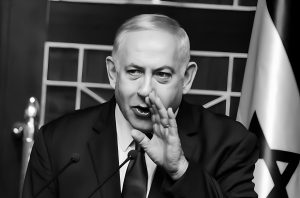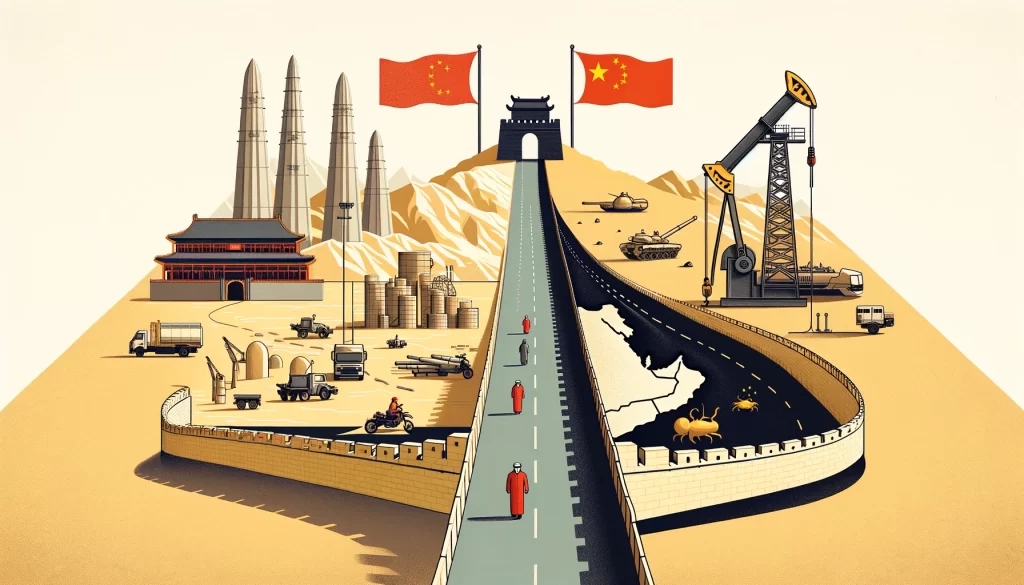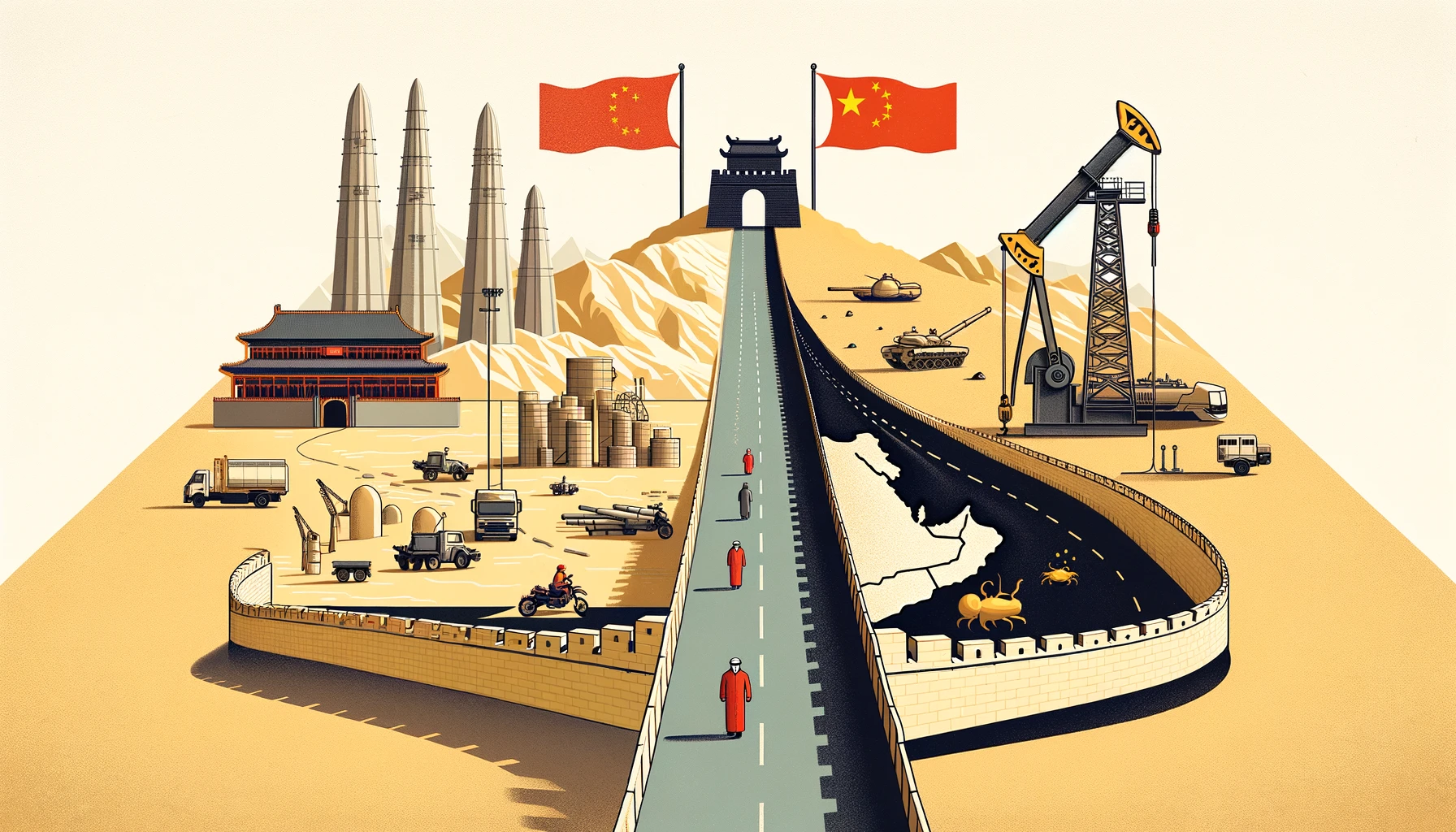
China’s Belt and Road Initiative enhances its economic investments and diplomatic efforts in the Middle East, reshaping regional balances and signaling the East’s rise in global power dynamics, marking the start of a new era in international relations.
MARCH 20, 2024

October 2023 marked ten years for China’s Belt and Road Initiative (BRI). First announced in 2013, the BRI is a plan to develop new trade routes connecting China with the rest of the world, through physical and technological development projects and financial investments. Over 150 countries have signed onto the BRI, including 21 out of 25 Arab states. Although trade relations between China and the Arab world far predates the Belt and Road Initiative, the BRI has opened the door for the China’s increased presence in the Middle East in the form of financial investments, infrastructure projects, and diplomatic relationships.
China is the primary trading partner for most Middle Eastern nations, providing substantial investments, infrastructure and advanced technology while also importing more oil than any other country in the world, half of which come from six Arab Gulf countries. China also holds stakes in at least 20 port projects in the Middle East. Investors from China and the Middle East have also signed numerous deals under the BRI framework, funding development projects and diversifying investments such as China’s 27-year LNG-supply deal with Qatar, a $7 billion currency swap agreement with the United Arab Emirates and Saudi Arabia, and the various deals worth over $10 billion signed at the 10th annual Arab-China Business conference in June 2023.
Under the BRI framework, 12 Arab countries have also formed comprehensive strategic partnerships with China, 17 Arab nations have endorsed China’s Global Development Initiative, 15 states are members of the Asian Infrastructure Investment Bank and 14 have participated in the “China-Arab Cooperation Initiative for Data Security”. In 2023, Saudi Arabia, the United Arab Emirates (UAE), Kuwait, Bahrain, and Egypt joined the Shanghai Cooperation Organization as dialogue partners while Iran was granted full membership.
These partnerships are an indication of China’s growing presence in the region. Although largely pushed by the BRI, some of these initiatives have been encouraged by external global forces. For example, the West has been recently shying away from Chinese technology, leading China to invest heavily in the Arab digital ecosystem instead, which is largely welcomed by both Arab leaders and the population. While other BRI projects have been government-led, these digital projects are being headed by private tech companies, developing an deeper, internal relationship between the Arab states and China that goes beyond state-sanctioned investments.
Pushed by global forces, the Digital Silk Road, along with the numerous other BRI initiatives China has led in the region, has, in turn, also effected global forces. The many developmental projects and investments led by China in the Arab region has left the country with a positive reputation among the Arab populations – many of whom, according to an Arab Barometer survey in late 2022, said they favored China more than the United States. This positive reputation has only been reinforced by China’s efforts of diplomatic mediation within the region, such as its reconciliation of the Saudi-Iran alliance in August 2023, and its meetings with Arab leaders to resolve the Israel-Palestine conflict since the October 7th attacks.
China’s involvement in mediating diplomatic conflicts such as these was only made possible by its growing economic presence in the region. By investing across the region financially, China gained some political power. It now had stake in the region’s politics, knowing any conflict could threaten its financial investments. Simultaneously, Arab leaders had an interest in keeping China happy, worried that otherwise the state will withdraw its investments. With China’s BRI initiatives have spanning across the region, China had the opportunity to develop relationships with numerous Arab states, regardless of inter-regional conflicts and divisions. This friend to all strategy put the state in a unique position in regional politics, giving it leverage with states on both sides of any regional fractures or divisions and allowing it to assert its presence across the entire region. This unique position in the region rich with oil and central to international trade routes also boosts China’s political influence on a global scale.
These recent patterns of behavior between China and the Middle East may indicate that global relations are shifting from the West to the East. Where historically, Arab leaders would look to the UK or to the US for conflict mediation and financial investments, they now appear to be looking to China. But it’s not that simple.
China’s increased presence in the Middle East, both financially and diplomatically, is not unchallenged. US officials, for example, are pushing Middle East tech groups to offload its investments and interactions in Chinese companies, citing concerns for national security, leaving the tech groups to pick between China and the US in their tech-war. The US is also still exerting its influence in regional politics, such as its heavy involvement in the Israel-Palestine conflict in the form of military, financial and diplomatic aid to Israel. Arab leaders, although developing relations with China, still look to the West for diplomacy and security alliances. And while America’s popularity in the region appears to be on a steady decline among the Arab people, they still look to the West for culture, popular trends and lifestyles.
China’s diplomatic leverage is not entirely fool-proof. The Arab states, regardless of their financial relationships with China, will ultimately act in what they consider to be their best interests, even if those interests do not align with their Eastern ally. Iran and Saudi Arabia, for example, have a long history of acting without concern for external pressures, and there is no telling if China’s position in the region is powerful enough to mediate or influence their behaviors a second time. Additionally, China only has influence in the region in the form of soft power. Although soft power can be very useful in political games, will it be enough for China to remain an influential global power in the oil-rich region?
A curated seletion of FA’s must-read stories.
Written By: SHAGNIK BARMAN
Written By: BERK TUTTUP
Written By: ABBY L’BERT
Written By: BILLY AGWANDA
Written By: HIRA SARWAR
Written By: BATUHAN GUNES
Written By: LEON REED
Written By: DARSHAN GAJJAR

Sussan Saikali a PhD Candidate in Political Science at Temple University. Her studies focus on Middle East politics, with a primary focus on identity politics and policy change.
Written By: GABRIEL RAMIREZ
Written By: DILARA SAHIN
Written By: DILRUBA YILMAZ
Written By: NILAY CELIK
Written By: ELDANIZ GUSSEINOV
Written By: JOSEF SCHOEFL
Written By: SELCAN BEDIRHANOGLU
Written By: FATIH CEYLAN
FA’s flagship evening newsletter guilding you through the most important world streis ofthe day. Delivered weekdays.
